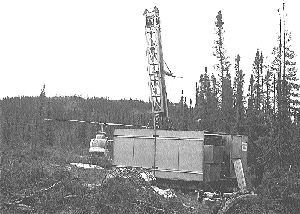As joint-venture partners
More than 700 heavy-mineral till samples have been collected on the property this year, and a number of priority anomalies are being further defined by ground geophysics in preparation of drilling. Additional staking has expanded the Foxtrot property by about 30% to 1,970 sq. km.
The Foxtrot property centres on the Renard cluster of eight kimberlitic intrusive bodies, a new field of highly diamondiferous kimberlites, 275 km northeast of Chibougamau. All eight kimberlites are diamond-bearing, relatively small and occur in an elongated 1.5-km-long area. During the upcoming drilling campaign, Ashton intends to put a few more holes into several of the known bodies as it begins to draw up plans for the collection of a larger bulk sample designed to recover at least 100 carats of diamonds.
“The bigger issue for the Renard cluster is firming up grade and finding out some idea about diamond value because it looks like we’ve got the potential for reasonable grade,” says Brooke Clements, Ashton’s vice-president of exploration.
During this past winter and spring, the Ashton and Soquem joint venture collected mini-bulk drill samples from the Renard 2, 3, 4 and 65 bodies. In addition, a mini-bulk sample weighing about 8 tonnes was collected from eight holes drilled into the Renard 1 intrusion during the summer.
Each of these bodies has a central core portion that consists of kimberlite breccia and subordinate hypabyssal kimberlite. The kimberlite breccia has a variable country-rock xenolith content. Peripheral to the core are zones of highly brecciated and fractured country rock, referred to as country-rock breccia, in addition to significant numbers of hypabyssal dykes ranging from less than 1 cm in thickness to more than 5 metres.
So far, Ashton has completed the dense media separation (DMS) processing of the Renard 65 and Renard 4 mini-bulk samples. A 17.6-tonne sample collected from 15 core holes into the Renard 65 body delivered 4.85 carats of diamonds larger than 0.85-mm square mesh, for an estimated diamond content of 0.28 carat per tonne (or 27.5 carats per 100 tonnes).
A 4-carat stone found embedded in the drill core during sample preparation was excluded from the preliminary grade calculation. “We cannot determine the weight of it to the accuracy we’d determined the weight of all the other [recovered] diamonds, so it’s really not consistent with our normal accuracy of disclosure,” says Clements, adding, “It’s not worth taking out of the core.” Clements says the 4-carat stone has much more geological and historical value left as it is embedded in the core. The stone, with exposed surface dimensions of 8.8 by 8.2 by 4.8 mm, is a colourless octahedral composite crystal.
If the 4-carat stone were to be included, the estimated diamond content of the 17.6-tonne sample jumps to 0.5 carat per tonne. The three largest stones recovered under the DMS processing weighed 0.77 carat (brown dodecahedral), 0.46 carat (grey composite crystal) and 0.2 carat (pale brown dodecahedral) apiece.
Kimberlite breccia with varying country rock xenolith content accounted for approximately 85% of the 17.6-tonne sample. The remainder consisted of hypabyssal material.
On a composite basis, 18.4 tonnes of material analyzed to date from Renard 65, including a 0.82-tonne sample collected in 2002, has an overall diamond content of 0.33 carat per tonne (excluding the 4-carat stone).
With a surface area covering 1.5 hectares, Renard 65 extends over a strike length of at least 300 metres, while averaging a width of 60 metres. The deepest hole ended in kimberlite at a depth of 294 metres.
The next step, according to Clements, is to firm up the grade of Renard 65 and find out how often the 4-carat stone, or something like it, occurs. “That can only be accomplished by taking bigger samples,” he says. “You need a bigger sample to flush out the grade and to find out if that 4-carat diamond was just a dramatic example of a nugget affect or if it occurs in some regular fashion throughout the body.
“At the moment, we are looking at the cluster as a whole and figuring out the most efficient and cost-effective way to get a bulk sample that will give us at least, say, 100 carats,” explains Clements. “We need to expose ourselves to some of those bigger stones and determine what they are worth.”
Diamond results for mini-bulk samples collected in 2003 from Renard 2 and Renard 3 are not yet available. Final results from Renard 4 were announced in June. A 5-tonne sample collected from 10 angle holes returned 1.46 carats of diamonds greater than 0.85-mm, for an implied grade of 0.29 carat per tonne. The two largest stones are a colourless octahedral and a pale brown dodecahedral, each weighing 0.11 carat.
Collectively, drilling on Renard 4 has yielded 8.2 tonnes of kimberlite breccia, from which a total of 4.07 carats were recovered, giving an estimated diamond content of 0.5 carat per tonne. A further 1.6 tonnes, described as country rock and country-rock breccia containing approximately 19% hypabyssal kimberlitic material, held 0.5 carat of diamonds, for an implied grade of 0.31 carat per tonne.


Be the first to comment on "Ashton, Soquem launch fall exploration campaign"